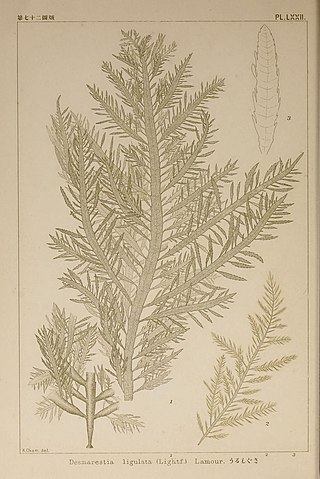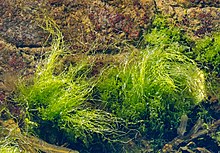
The sea lettuces comprise the genus Ulva, a group of edible green algae that is widely distributed along the coasts of the world's oceans. The type species within the genus Ulva is Ulva lactuca, lactuca being Latin for "lettuce". The genus also includes the species previously classified under the genus Enteromorpha, the former members of which are known under the common name green nori.

Ulva lactuca, also known by the common name sea lettuce, is an edible green alga in the family Ulvaceae. It is the type species of the genus Ulva. A synonym is U. fenestrata, referring to its "windowed" or "holed" appearance.

AlgaeBase is a global species database of information on all groups of algae, both marine and freshwater, as well as sea-grass.

Colpomenia peregrina, sometimes referred to by its vernacular names oyster thief and bladder weed, is a species of brown seaweed.

Alaria is a genus of brown alga (Phaeophyceae) comprising approximately 17 species. Members of the genus are dried and eaten as a food in Western Europe, China, Korea, Japan, and South America. Distribution of the genus is a marker for climate change, as it relates to oceanic temperatures.

Codium fragile, known commonly as green sea fingers, dead man's fingers, felty fingers, forked felt-alga, stag seaweed, sponge seaweed, green sponge, green fleece, sea staghorn, and oyster thief, is a species of seaweed in the family Codiaceae. It originates in the Pacific Ocean near Japan and has become an invasive species on the coasts of the Northern Atlantic Ocean.

Ulva linza is a green alga in the family Ulvaceae that can be found in British Isles.
Ulva clathrata is a species of seaweed in the family Ulvaceae that can be found in such European countries as Azores, Belgium, Ireland, Netherlands, and the United Kingdom. It is also common in Asian and African countries such as Israel, Kenya, Mauritius, South Africa, Tanzania, Japan, Portugal and Tunisia. It has distribution in the Americas as well including Alaska, Argentina, Brazil, Cuba, Grenada, Hispaniola, and Venezuela. Besides various countries it can be found in certain gulfs, oceans and seas such as the Gulf of Maine and Gulf of Mexico, Indian Ocean and European waters.
Ulva polyclada is a species of seaweed in the family Ulvaceae that can be found in Australia and New Zealand.
Ulva ohnoi is a species of light-green coloured seaweed in the family Ulvaceae that is endemic to Japan.

Desmarestia ligulata is a species of brown algae found worldwide. Its common names include color changer, Desmarest's flattened weed, and sea sorrel, though the last name can also refer to other species of Desmarestia.

Hypoglossum hypoglossoides, known as under tongue weed, is a small red marine alga in the family Delesseriaceae.
Saccharina dentigera is a species of brown algae, in the family Laminariaceae. It is native to shallow water in the northeastern Pacific Ocean from the Gulf of Alaska to Baja California.
Zanardinia is a monotypic genus of seaweed in the brown algae. The only species, Zanardinia typus, commonly known as penny weed, is native to the northeastern Atlantic Ocean and the Mediterranean Sea.









